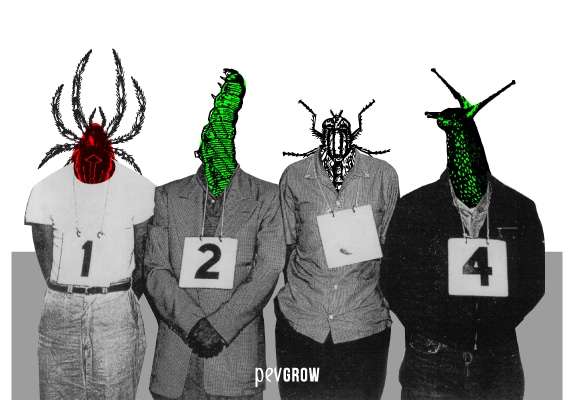

31-10-2019 09:00:56 - Updated: 31 October, 2019
Let’s go over the most common plagues that attack our marijuana plants, even taking into account that we can also find fungi and other diseases in our crops. We must be able to recognise the type of attack as soon as possible, so that the damage caused is minimal. To better differentiate the various pathogens that can ruin our cannabis harvest. Let’s start with the insect pests we see most in marijuana crops.
⭐ Which insects attack cannabis the most?
In some regions some types of pests form more and in other areas other types develop better. This is because each pest expands best under certain conditions. Nevertheless the most common insect pests found in marijuana crops are:
- Red Spider
- Thrips
- Whitefly
- Aphids
- Caterpillar
- Mealybugs
- Miners
- Snails and slugs
- Substrate Fly
- Micro-Mites
⛳ Red Spider, the most feared plague in cannabis
The red spider, scientifically named Tetranychus Urticae, is the pest that most attacks cannabis in indoor and greenhouse crops. This is due to its easy development and reproduction in hot and dry environments, such as a growing cabinet that does not have good ventilation or refrigeration in summer.
The first symptoms we see in the plants are a few stings in the leaves, which at first may go unnoticed because they are very small, but they become more and more obvious. Unlike other pests such as thrips, where bites are seen more by the edges of the leaves, or the white fly, which prefers the nerves on the underside of the leaf, the red spider bites all areas of the leaf, also differ their smaller bites than those of the trip.
If it is not treated properly, and the growing conditions are not the best, you may not be able to harvest, because when the special conditions for reproduction are in place, the red spider multiplies at an incredible rate. From one day to the next you can see the upper buds covered by spider web.
How to prevent and treat Red Spider?
The best thing is always to prevent so as not to have to heal, keeping the temperature below 25 ºC, and the humidity around 50% there are many possibilities of not seeing it. It is also important to be careful when visiting other crops, or when bringing other people’s cuttings, as we can bring the spider into our crop without realizing it.
The biological fight is another way of prevention and control of the red spider, the Amblyseius Californicus are worth to avoid the appearance of the red spider, but if you already have it and you want to eliminate it without using insecticides you have other better options. Phytoseiulus persimilis is an effective predator of this marijuana pest, and by combining Californicus with Persimilis you can keep the destructive red spider under control.
If unfortunately we have not been able to prevent, and there comes a time when you have a plague of red spider, there are insecticides that work well as Borneo, but it is increasingly difficult to eliminate red spider in cannabis crops. A few years ago Abamectin was very effective against this pest, especially when combined with potassium soap, but now it costs a lot to eradicate 100% of this mite with Abamectin.
If not treated properly this pest can be very destructive, ends up forming cobwebs on buds and every part of the plants, being able to even destroy the harvest.
Homemade remedies to prevent red spider attack
We know that the dreaded red spider does not like humidity or cold, so one way to prevent its appearance is to spray the leaves with cold water during the night period until the plants begin to flower.
The tea or infusion of nettles is also effective, but only as prevention, if the plague is already settled it is not very effective.
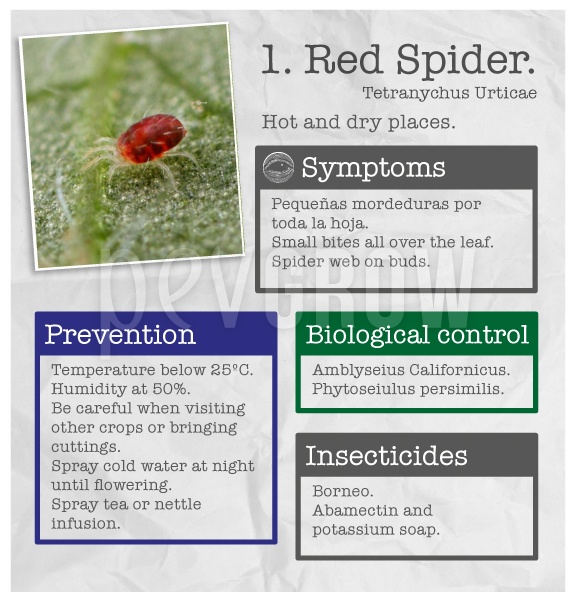
✨ Thrips in cannabis
Thrips, whose scientific name is Frankliniella Occidentalis, are elongated insects, measuring from 1 mm. to 3 mm. long but can measure up to 6 mm. They have wings when they are adults, and their color can be yellow, red, brown, gray or white.
They belong to the Tisanoptera family, of which 5,600 different species, being the most common the one that attacks our beloved plant.
The first sign of thrips attack that we see on our plants are their bites on the leaves, larger at first sight than those of the red spider. If you look around you can see the thrips moving through the leaves that have bites. If the plague advances we will see black dots on the leaves, they are the excrements of the trip. This plague, unlike others, is not going to finish with the harvest, but it will diminish it, in many cases considerably. In addition, they are carriers of viruses, mainly of the Tospovirus type, which are incurable and cause production to decrease greatly.
Effective insecticides against thrips
In order to fight thrips it is enough to use pyrethrin, since this plague is not as aggressive as others, but still the best thing to do is to try not to let this one show up. To prevent the appearance of thrip, the ideal is to treat the plants with potassium soap or neem oil sprayed, from the second or third week of life of the plant.
A quick way to detect the thrip is with the help of blue sticky traps, since these insects are highly attracted by that color.
Can I end thrips with homemade tricks?
Luckily you can, thryp is not as destructive as red spider. With a garlic extract, we can put an end to this plague without any problems. To achieve it we have to crush a garlic as much as possible and dilute it with water. Then spray all the leaves, both on the face and on the underside, with this mixture.
Garlic is totally harmless for plants and for us, so this solution can be applied as a preventive and also to combat the attack of thrips
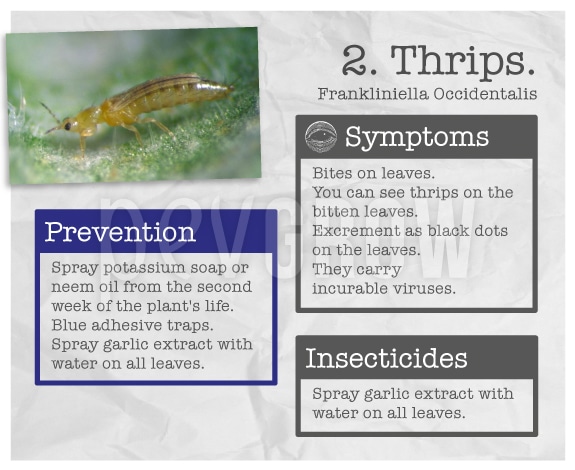
👌 Whitefly in marijuana crops
The white fly is a flying insect that as its name indicates is white and a size of about 2 mm. It belongs to the Aleurodidae family, classified as homopterous insects, and is one of the most common pests of cannabis, both indoors and outdoors.
Normally they hide on the underside of the leaves, the place where they incubate the eggs, which are usually about 200 for each laying. They usually appear in environments with high temperature and humidity, so we see more in summer, and the first signs that we notice is the chlorosis or discoloration in the leaves, which if we don’t fix them, they dry up and fall.
But the damage of this plague does not end there, the white fly secretes a molasses that ends up causing the appearance of the fungus called “Bold“. This fungus weakens plants, preventing them from photosynthesizing normally.
Effective Insecticides to combat the Whitefly
As against the thrip, one of the best ways to eliminate the whitefly is with pyrethrins, also the rotenone can be effective, and of course other more powerful chemical insecticides, but those you should always try to avoid them.
To prevent the appearance of the whitefly, it is enough to periodically spray plants with Neem oil or potassium soap from the second week of life. Setting yellow sticky traps helps uncover the pest before you see them on the leaves.
Is there a homemade remedy to prevent or fight the Whitefly?
In outdoor crops you can put basil next to your cannabis plants to repel the whitefly. This will help prevent their appearance, as the aroma of basil repels these insects.
Garlic extract is used to eliminate the whitefly naturally. We peel some garlic cloves and dilute them in water. With this solution we spray all the plants well, especially on the underside of the leaves.
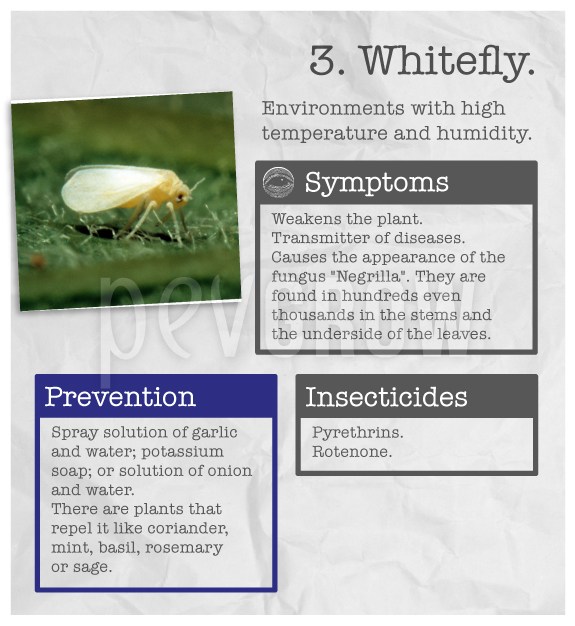
☕ Aphids in marijuana crops
The aphid is an aphid insect, which belongs to the family of hemiptera, and its appearance in cannabis crops can be a problem for several reasons. The main one is that it is a parasite that feeds on plants, weakening and diminishing their production. Another problem represented by the aphid pest in cannabis is that it is an insect that acts as a vector, transmitting other diseases.
Aphids have a size of 1 to 3 mm. and can be of various colors, white, yellow, black or green, some have wings to move, and in the abdomen have a protuberance that serves to secrete a substance used as a defense, as it repels their predators. They also secrete another sweet substance through the anus that serves as food for ants, which live in symbiosis with the aphids and defend them from their natural predators in exchange for this food.
You can normally find them on the stems and the underside of leaves, where hundreds or thousands of them can accumulate. If you look close you can see them move from one side to the other, and the plague forms quickly because its reproduction cycle is quite short, especially indoors.
The damage it causes to the plant with the naked eye is not appreciated before detecting the pest, normally the aphid is seen before directly, but that does not mean that it does not harm the plants, because as we said, it can cause other diseases such as viruses. Another side effect is that the molasses secreted by the aphids causes the appearance of the bold fungus, as it happens with whitefly.
How to eliminate aphid in cannabis crops?
Rotenone is quite effective against aphids, other natural remedies such as garlic can also help. As prevention is always the best option, with periodic sprays of potassium soap should not come to form the plague.
Biological control may also be a good option in this regard, as aphids have many natural predators, such as the common ladybug.
Are there homemade tricks to fight aphids?
Of course they also exist, both to prevent the aphid from visiting and to kill it. There are repellent plants such as coriander, mint, basil, rosemary or sage that serve to effectively repel this insect.
We can also use an onion extract, to prepare it we peel an onion, chop it and put it in a bottle with water. This mixture is left to rest 24 hours, then boil the contents and when it cools we can use it pulverized.

📖 Caterpillar during flowering
There are several types of caterpillars that attack marijuana plants, but the most common and destructive is the one of the genus Spodoptera. This is one of the worst pests that can affect us, and basically comes out in outdoor cultivation.
This plague does not appear by chance, although we do not normally see it, in summer a butterfly lays eggs on the leaves of our beloved plants, and after a while we see the dreaded caterpillars appear coming out of the buds.
When the caterpillars come out the damage is already done, and the worst thing is not the hole they make in the buds, this pest is the worst because the caterpillars defecate inside the flowers causing pockets of moisture that end up becoming fungi.
How to prevent caterpillar attack?
There is a fairly effective natural product if used properly, Bacillus Thurgiensis. It is a bacterium that when eaten by the caterpillar destroys its digestive system and it can no longer eat. It is very interesting to start using Bacillus in summer, before the plants start to bloom.
Can I use homemade remedies to prevent caterpillar attack?
You can, but with this pest we really recommend using Bacillus Thurgiensis, as it is cheap, natural, harmless and very effective. But if you want to prevent the attack of caterpillars on cannabis crops with homemade remedies you can try an infusion of pepper and garlic.

📲 Mealybugs in Cannabis
There are many types of mealybugs, with different sizes, shapes and colors. One of the most common ones that attack our friendly plant is the cotton Cochinilla. This insect attacks above all the stems of the plants and although it is not one of the most destructive it is advisable to treat them when they appear.
This plague weakens the plant and can even dry some branches. They also secrete a cotton-like substance that ends up forming fungi, so the sooner action is taken to eliminate them better.
How can I eliminate the mealybugs from marijuana?
There are several ways to treat this plague, such as tearing them by hand for example. Another useful way is to dip a cloth in alcohol and rub the stems. It can also be made with potassium soap or garlic extract, as mealybug is not very strong and comes out easy.
How can I fight mealybugs with home remedies?
One of the best ways to kill a cochineal pest in marijuana crops is by hand. To do this we must mix water and alcohol with the same proportions, spray the plants with this solution and then rub with a cloth especially on the stems.
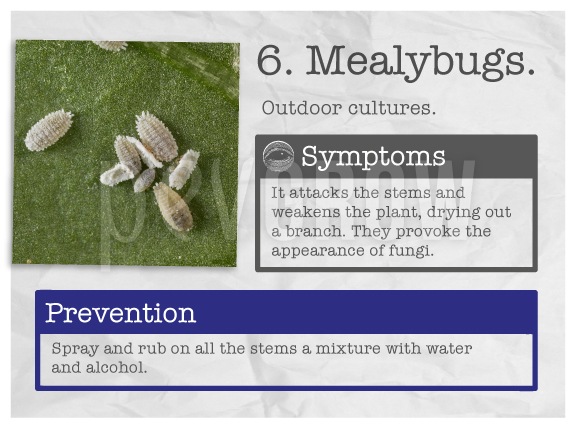
➕ Cannabis Leaf Miners
This is a more common pest in outdoor crops than indoors and it won’t really kill the plant, but it can weaken it. They are called miners because they get inside the leaves, digging tunnels, while feeding it leaves a trail easily visible to the naked eye.
Affected leaves can dry out, so the plant loses both its food reserves and the solar panels used for photosynthesis.
How to kill miners?
The best thing is to prevent, for this plague and for all the others. The particularity of getting into the leaves makes the miner very resistant to insecticides sprayed, as the leaf itself protects him. We can use Neem oil in irrigation, so that the plant assimilates it in a systemic way and ends up ingested by miners.
What homemade remedies exist to combat the miner?
An effective way to eliminate this pest is to crush them with your fingers. Thanks to the trace that is left by where it passes we can have located, so it is not difficult at all.
To try to prevent its appearance we can prepare an extract of wormwood. Mixing a liter of water with 200 grams of wormwood and boiling the mixture 1 hour, then let it stand for 1 day, then strain, and we can use it.
It is necessary to spray every day with this solution if we already have a leaf miner plague, or once a week if it is to prevent this and other plagues.
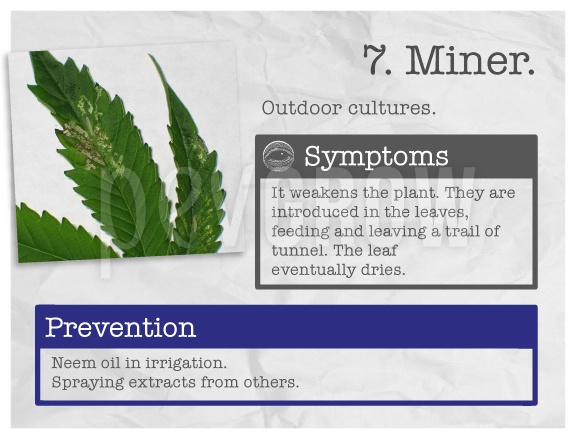
🚀 Snails and slugs in outdoor cultivation
It is an almost exclusive plague outdoors, although in mixed crops you can also find them, surely from outside. They can be very destructive, especially when the plant is small. A snail can end up with a seedling or a plant with 2 or 3 knots in just a few hours.
That is why it is important to germinate and give some growth time to the plants in some protected site. If slugs or snails attack a medium or large plant the damage will remain on a leaf or a little more. However, if the plant is very small we take the risk of losing it.
Snails bite the leaves creating irreversible damages, but in addition the trace of slime that they leave can create a focus of infection by fungi. That is why it is so important to prevent, many times when we see the plague it has already caused much damage to plants.
How can you prevent snails and slugs?
There are commercial products effective against the attack of snails and slugs, but sincerely we can avoid them, because the fewer insecticides we use the better. Therefore I recommend you to use home remedies to avoid slugs.
What are the best homemade remedies to prevent the attack of snails and slugs?
Although there are specific products to fight against these animals, it is preferable to try not to get them to your plants. If they are planted in pots, it is easy to place barriers that prevent them from reaching them, or to go directly up the plants to some place that the snails cannot reach.
In case of being planted in mother earth what we can do is to create a barrier around the stem of the plant, to a distance of 30 or 40 cms. You can make this barrier with ash, salt sand, lime or diatomaceous earth, and this way they won’t get past it.
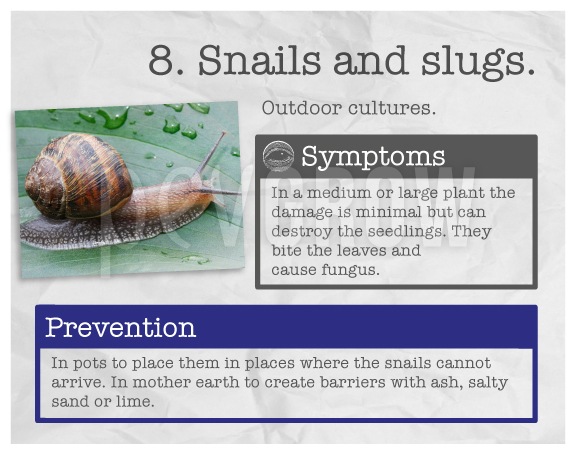
✅ Substrate fly in cannabis crops
Substrate flies or soil flies usually appear in crops where the soil remains moist for a long time. They normally hide under the substrate, where they reproduce with clutches of about 200 eggs at a time.
It is not a deadly plague, the damage they create is barely visible to the naked eye, as they attack the capillaries of the roots. This weakens the plant, as it prevents them from feeding normally, but the worst is not really that. The wounds that they create in the root zone can be the entrance for much more lethal plagues, such as fungi of the Pythium or Fusarium type.
How can I detect and remove the substrate fly?
The best way to detect this and other pests that attack cannabis plants is with sticky traps. Normally before you see the damage caused by insects on plants you will see them stuck in the traps.
Another way to see them is with the naked eye, since they are like small flies the size of a mosquito that fly over plants. If the plant has resin you will see some of them stuck in leaves and buds.
To eliminate them there is a very good method that is the earth of diatom, a compost is created on the substrate of each flowerpot, with 1 cm approximately is sufficient. You can also make mulch with vermiculite, but the diatom is more effective. Bacillus Thurgiensis is also very effective.
To prevent their appearance the best thing is to respect the dry cycles between irrigations, to water and to pulverize oil of neem since the plants are small, to maintain environmental humidity controlled and a clean culture.
Are there no homemade remedies to prevent substrate fly?
Of course there are, although they are not as effective as those described above. Lemon peels can be placed on the substrate, as this aroma repels this and other pests, especially flies and mosquitoes.
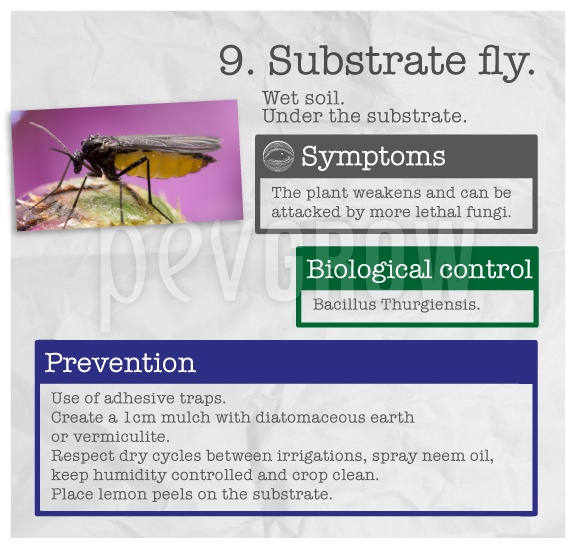
🔥 What are micro-mite attackers of cannabis?
Micro-mites are tiny insects of the arachnid species, almost imperceptible to the human eye. They like high humidity, that’s why they tend to hide in the tender buds and the center of the leaves. They can appear in our crops due to many factors, because they are so small we can transport them without realizing it, and they can even be accompanied by the whitefly or other insects.
How can we detect a plague of micro-mite?
The first thing we are going to notice is a slowdown in the development of the plant. If it is in the period of growth you will see that malformations appear, with the leaves wrinkled or atrophied, in which necrosis can appear. New outbreaks that barely develop, if ever, will also be affected.
If the plague arrives during flowering, the first thing you will notice is that the plant stops flowering normally. They stop producing new flowers and the ones they have no longer develop in the same way, the pistils wither as if the plant were already ripe, but obviously with much less production.
So, if we suffer a plague of micro-mite, will our plants die? It is possible, although it does not affect all equally, normally they attack more the weakest plants, and these can die. Luckily for other plants it does not do so much damage, so you can get to harvest, although with less production obviously.
Is it possible to eliminate a plague of micro-mite?
It is difficult to totally eliminate micro-dust mites, but the most effective is biological control. Amblyseius Fallacis and Amblyseius Cucumeris are the most recommended. But really the most interesting thing if it comes to you in growth is to eliminate the plants, clean and disinfect thoroughly, and start again. On the other hand, if it is in flowering and there is not much left to harvest, you should prove the biological fight.
How can I fight micro-mite with homemade remedies?
Something that slows down the development of this plague is garlic extract. To do this, mix 10 grams of peeled and chopped garlic with 1 litre of water. Tanaceto’s infusion can also work, but it must be clear that it is a very difficult mite to eliminate in its entirety.
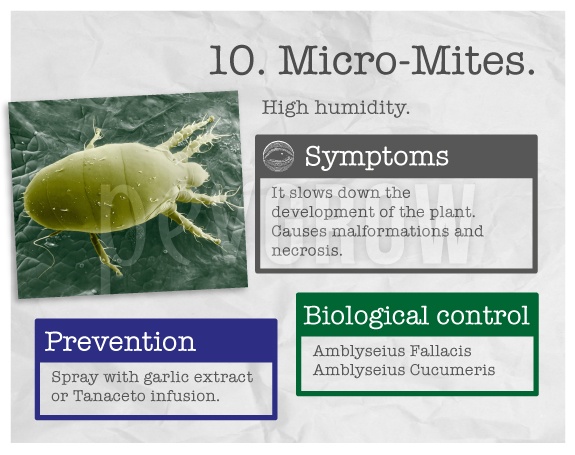
– How to use the potassium soap correctly
– Biological techniques for control pests in your marijuana plants
– How to Use Neem Oil in Marijuana Growing
🎯 Conclusions
As you may have noticed, the most important point is always prevention. If you know how to recognize an insect plague quickly and act immediately, it is easy to kill it, but even better if it does not appear.
Most of the pests that attack cannabis appear and develop much faster in crops that are not very clean, so try to keep everything neat.
If you know of any other insect attacking our beloved plant we would like you to tell us, and if you liked the article we would appreciate you sharing it.






The best solution I’ve found for snails and slugs is putting a small container of beer close to the plant using something like the top of a mayo jar. They love the beer so much that they will drown themselves in it and not go anywhere near your plants. Be sure to check your traps every day or two so you can get rid of the dead ones and replace the beer. I found this method to be100% effective!
This is one of the best articles I’ve read regarding the plagues our beloved plants face. I’ve grown indoors and outdoors and faced many challenges including having to sacrifice an entire crop. I only wish I had read this much earlier. Great job on describing ways to prevent these pests as well as identifying and eliminating. I’ve tried the expensive fungicides and pesticides with varying results. The best action is always prevention and the information on the home made deterrents is invaluable.
Hello!
Thank you very much!
Exactly, with homemade methods we can take good care of our little